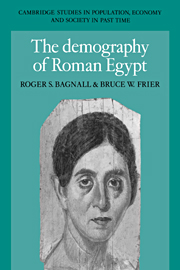Book contents
- Frontmatter
- Contents
- List of figures
- List of tables
- Foreword
- Preface
- A note on references and abbreviations
- 1 The census returns
- 2 The census returns as demographic evidence
- 3 Households
- 4 Female life expectancy
- 5 Male life expectancy and the sex ratio
- 6 Marriage
- 7 Fertility
- 8 Migration
- 9 Conclusion
- Catalogue of census declarations
- Catalogue of census declarations Supplement
- Appendixes
- Bibliography
- Index
- Cambridge Studies in Population, Economy and Society in Past Time
1 - The census returns
Published online by Cambridge University Press: 06 January 2010
- Frontmatter
- Contents
- List of figures
- List of tables
- Foreword
- Preface
- A note on references and abbreviations
- 1 The census returns
- 2 The census returns as demographic evidence
- 3 Households
- 4 Female life expectancy
- 5 Male life expectancy and the sex ratio
- 6 Marriage
- 7 Fertility
- 8 Migration
- 9 Conclusion
- Catalogue of census declarations
- Catalogue of census declarations Supplement
- Appendixes
- Bibliography
- Index
- Cambridge Studies in Population, Economy and Society in Past Time
Summary
The documents and the history of the census
This book is a study of the population of Egypt in the first three centuries of Roman rule. Its central questions concern the size and structure of Egyptian households, the population's age and sex distribution, and the patterns of mortality, marriage, fertility, and migration that are likely to have prevailed in Roman Egypt. The basis for all of this inquiry is a body of about 300 census declarations, of which the earliest dates to AD 12 and the latest to AD 259 (but survives only in a later copy, perhaps from around 266). These declarations are by no means the only evidence for the ages of the residents of Egypt in this period, but they are the only sizable corpus of evidence that at least purports to provide complete rosters of particular households, whatever the age, sex, or status of their members. The problems inherent in constructing statistics from any assemblage of ancient data are considerable. It has been our view that these problems could best be mitigated by a firm exclusion of all texts that could not with reasonable certainty be taken to be census declarations, copies of declarations, or full extracts of the lists of persons from declarations. That is not to say that all problems are thus removed. Chapter 2 is devoted to an assessment of the quality of these data from the point of view of demography.
Before we come to that assessment, however, the reader needs to understand the process by which these texts were created.
- Type
- Chapter
- Information
- The Demography of Roman Egypt , pp. 1 - 30Publisher: Cambridge University PressPrint publication year: 1994
- 1
- Cited by



